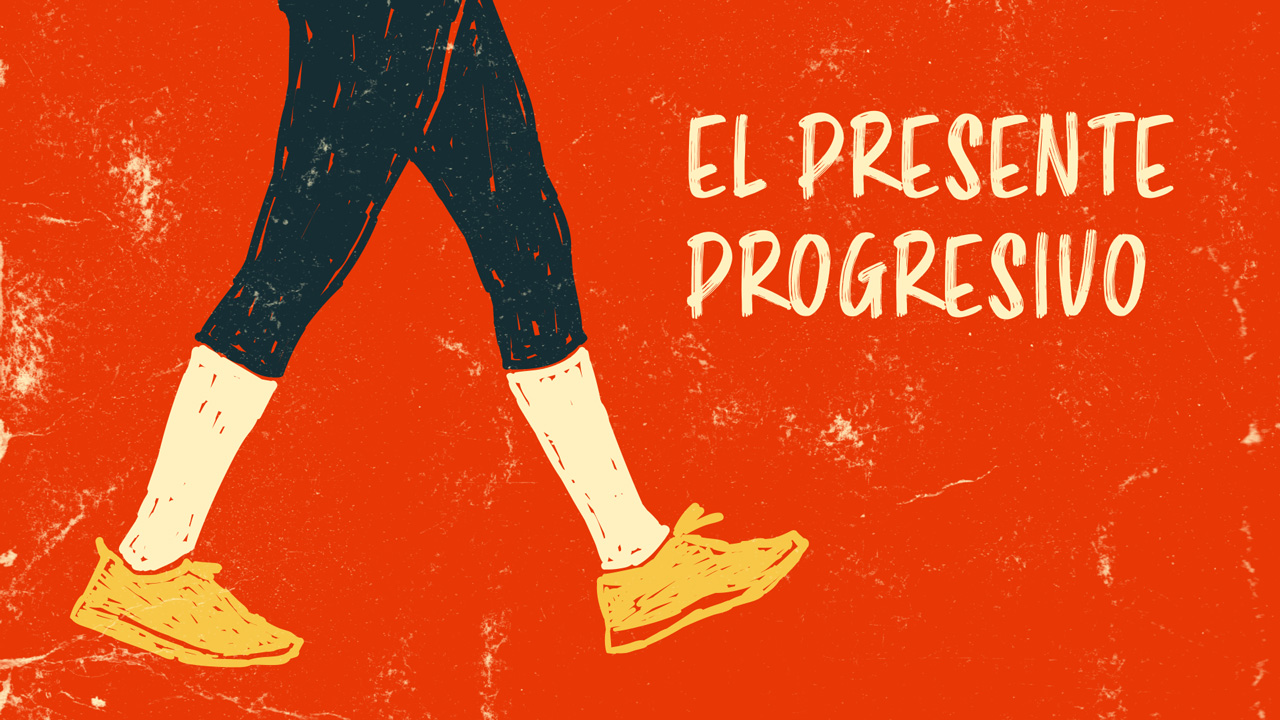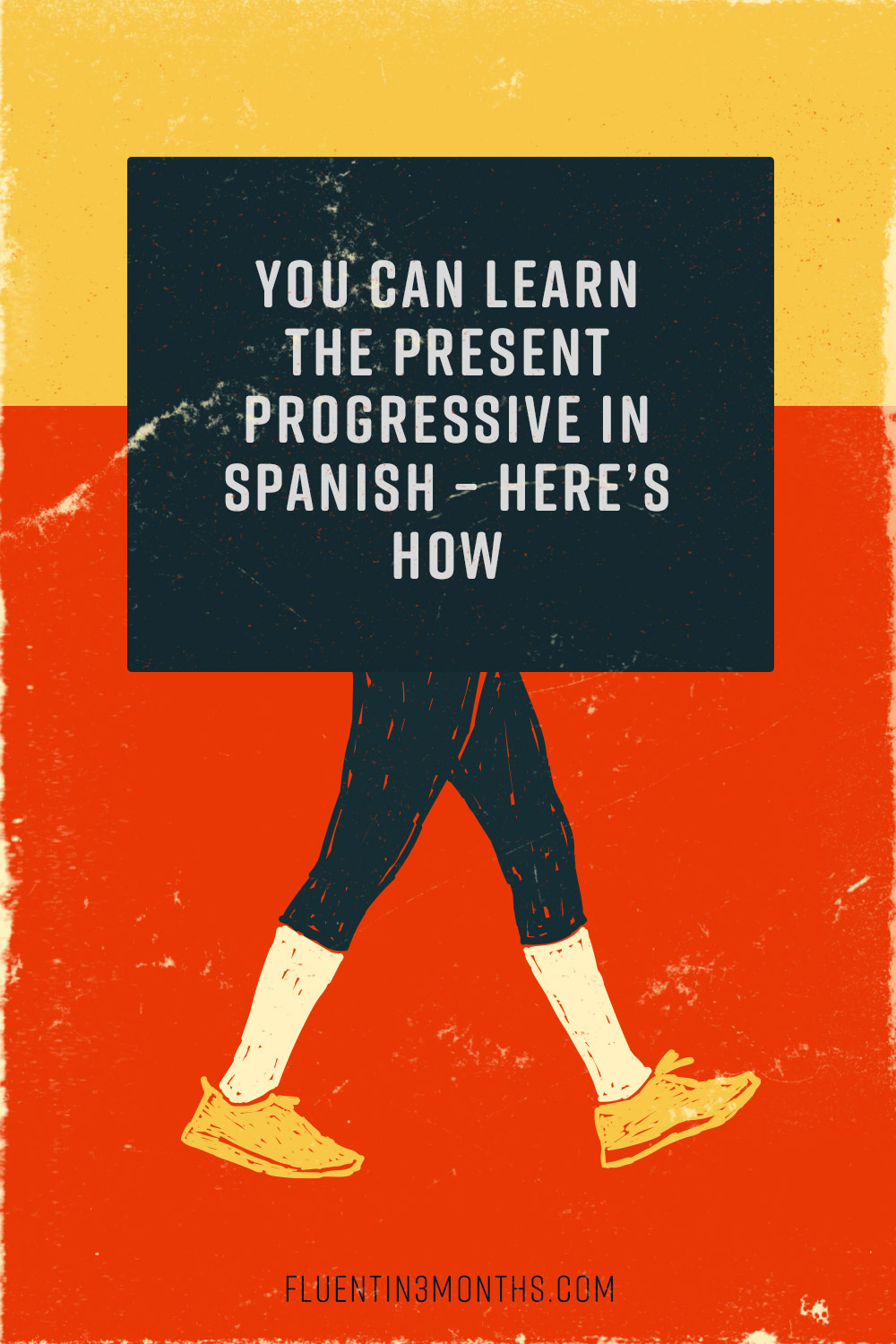Present Progressive in Spanish Made Easy [With Examples & Charts]
Are you struggling in your fight with present progressive in Spanish? If your answer is “yes”, this article will be the superhero that rescues you.
Conjugation isn’t the easiest thing about Spanish. In fact, it can be quite intimidating if you try to tackle this villain the wrong way. It seems so different from what we know in English!
But don’t worry, I can help you power through it.
In this post, I’ll give you an in-depth explanation of the present progressive tense in Spanish.
Want to hear the best part? I’ll keep it simple. And I’ll include many examples and charts to make sure you master it all.
So what do you say? Let’s be allies?
Great! Grab your cape and your mask, my friend, because we’re about to kick some Spanish conjugation!
What Is “Present Progressive” in Spanish?
To understand what “present progressive” means in Spanish, let’s first refresh your memory on what it is in English.
Progressive verb tenses, also called “continuous tenses”, describe actions that are in process or unfinished.
Examples:
- I was going to come.
- I am eating breakfast.
- I will be sleeping.
As you can see, progressive tenses are formed with a conjugated verb “to be” and the “-ing” form of another verb.
Our enemy number one at the moment is the second example, the “present progressive” tense: “I am eating.”
Now let’s talk about el presente progresivo, the “present progressive” in Spanish.
How to Form El Presente Progresivo, the Present Progressive Tense in Spanish
Before we get started, there’s something I have to tell you.
In the introduction, I mentioned how it seems like Spanish conjugation is very different from English conjugation. That’s what it might feel like… But we experienced language superheroes know better.
In fact, the two share some similarities when it comes to structure.
The presente progresivo, also called presente continuo (“continuous present”), follows this layout:
simple present tense of the verb estar (“to be”) + gerundio (“gerund” or the -ing form of a verb)
Examples:
- Estoy comiendo. – “I am eating.”
- Estás hablando. – “You are talking.”
¡Ojo! (“Watch out!”): There are two verbs that translate to “to be” in Spanish: ser and estar.
Estar in Spanish means “to be” in a temporary moment. It makes sense that it’s the verb used for the present progressive, the time that describes an unfinished or in-process action.
Estar – The Simple Present Conjugation of “To Be”
As we’ve seen above, you need two words to form an invincible present progressive phrase in Spanish. Let’s learn about the first one: the simple present tense of estar.
Here is a conjugation chart:
| Estar (“to be”) | |
|---|---|
| yo estoy | I am |
| tu, vos estás | you are (singular informal) |
| él, ella, usted está | he, she is / you are (formal singular) |
| nosotros, nosotras estamos | we are |
| vosotros, vosotras estáis | you are (plural informal in Spain) |
| ellos, ellas, ustedes están | they are / you are (plural formal in Spain, standard plural in Latin America) |
Los Gerundios – “The Gerunds”
The second part of the power combo is the “gerund”. You might recognize it more easily if I disclose its secret identity: it’s the “-ing” form of a verb. You know, like “running” or “fighting”.
You take the root of the verb and add “-ing” at the end.
In Spanish, it is a bit more tricky to make up a gerund.
The main rule still is to use the root of the verb, but the ending is treated differently. A verb’s gerund depends on what group the verb belongs to: first or second and third.
Think of the verb groups as superhero teams that unite verbs with the same traits:
- all verbs ending in -ar belong to the first group. Examples include hablar (“to speak”) and llamar (“to call”).
- all verbs ending in -er belong to the second group. Verbs such as comer (“to eat”) and saber (“to know”).
- all verbs ending in -ir belong to the third group. Think of dormir (“to sleep”) and reír (to laugh”).
To form the gerund, remove -ar, -er, and -ir from the verb and replace it with the appropriate ending.
The gerund’s ending for a verb that belongs to the first group is:
-ando → hablando (“eating”), cocinando (“cooking”)
The gerund’s ending for the verbs that belong to the second and third group are:
-iendo → comiendo (“eating”), riendo (“laughing”)
¡Ojo! There are some exceptions to the rule. I’ll talk more about them later in the post.
Now… Onto the Spanish Present Progressive Examples!
I told you at the beginning of the post that I would add to our journey with charts and examples to make the topic easier to understand.
Well… The time has come.
Spanish Present Progressive – First Group
| Estar hablando (“to be talking”) | |
|---|---|
| yo estoy hablando | I am talking |
| tu, vos estás hablando | you are talking |
| él, ella, usted está hablando | he, she is talking / you are talking |
| nosotros, nosotras estamos hablando | we are talking |
| vosotros, vosotras estáis hablando | you are talking |
| ellos, ellas, ustedes están hablando | they, you are talking |
Note: Verbs such as dar (“to give”), cocinar (“to cook”), trabajar (“to work”), llegar “(to arrive”), pasar (“to pass”), dejar (“to leave”), and llamar (“to call”) follow this pattern.
Spanish Present Progressive – Second Group
| Estar comiendo (“to be eating”) | |
|---|---|
| yo estoy comiendo | I am eating |
| tu, vos estás comiendo | you are eating |
| él, ella, usted está comiendo | he, she is eating / you are eating |
| nosotros, nosotras estamos comiendo | we are eating |
| vosotros, vosotras estáis comiendo | you are eating |
| ellos, ellas, ustedes están comiendo | they, you are eating |
Note: Ser (“to be”), tener (“to have”), hacer (“to do”), ver (“to see”), saber (“to know”), querer (“to like” or “to want”), and parecer (“to look like”) are a few examples of second-group verbs that conjugate like comer for this tense.
Spanish Present Progressive – Third Group
| Estar viviendo (“to be living”) | |
|---|---|
| yo estoy viviendo | I am living |
| tu, vos estás viviendo | you are living |
| él, ella, usted está viviendo | he, she is living / you are living |
| nosotros, nosotras estamos viviendo | we are living |
| vosotros, vosotras estáis viviendo | you are living |
| ellos, ellas, ustedes están viviendo | they, you are living |
Note: A lot of the third-group verbs are irregular and do not follow the same pattern as vivir. However, there still are a few, like salir (“to exit” or “to go out”), escribir (“to write”), and recibir (“to receive”).
Irregular Present Progressive – The Rebel Verbs
There are two types of “irregular” verbs when it comes to gerunds:
- Those who don’t keep their root for the gerund. I don’t know if they’re trying to be creative or just want to have a cooler spelling. The point is, watch out for the verbs whose root changes when they shift into gerund format.
- Those whose spelling makes it necessary to change the suffix -iendo into -yendo.
Keep in mind that only verbs of the second and third group can be irregular. All the verbs of the first group follow the standard gerund rules.
Let me give you a few examples here with -ir verbs
| Estar yendo (“to be going”) | |
|---|---|
| yo estoy yendo | I am going |
| tu, vos estás yendo | you are going |
| él, ella, usted está yendo | he, she is going / you are going |
| nosotros, nosotras estamos yendo | we are going |
| vosotros, vosotras estáis yendo | you are going |
| ellos, ellas, ustedes están yendo | they, you are going |
Leer
| Estar leyendo (“to be reading”) | |
|---|---|
| yo estoy leyendo | I am reading |
| tu, vos estás leyendo | you are reading |
| él, ella, usted está leyendo | he, she is reading / you are reading |
| nosotros, nosotras estamos leyendo | we are reading |
| vosotros, vosotras estáis leyendo | you are reading |
| ellos, ellas, ustedes están leyendo | they, you are reading |
Dormir
| Estar durmiendo (“to be sleeping”) | |
|---|---|
| yo estoy durmiendo | I am sleeping |
| tu, vos estás durmiendo | you are sleeping |
| él, ella, usted está durmiendo | he, she is sleeping / you are sleeping |
| nosotros, nosotras estamos durmiendo | we are sleeping |
| vosotros, vosotras estáis durmiendo | you are sleeping |
| ellos, ellas, ustedes están durmiendo | they, you are sleeping |
Caer(se)
| Estar cayendo(se) (“to be falling”) | |
|---|---|
| yo (me) estoy cayendo | I am falling |
| tu, vos (te) estás cayendo | you are falling |
| él, ella, usted (se) está cayendo | he, she is falling / you are falling |
| nosotros, nosotras (nos) estamos cayendo | we are falling |
| vosotros, vosotras (os) estáis cayendo | you are falling |
| ellos, ellas, ustedes (se) están cayendo | they, you are falling |
Note: Caerse is a reflexive verb that means “to fall”. If you are interested in reflexive verbs, I advise you to take a look at this post where I wrote about them. I hope you like space travelling for that mission.
Estamos Llegando al Final de La Misión – “We Are Reaching the End of the Mission”
Here we are: the end of the feat. Congratulations, you’ve conquered the present progressive tense in Spanish!
I guess you could say you’re the master of presente progresivo now. And I am honoured to have been by your side along the way.
Have you enjoyed my superhero talk through the post? Honestly, I think it’s a lot more fun to learn something tough through fun explanations. And you know what else is fun? Talking about superheroes in Spanish!
I didn’t do it here because you already had a lot to keep an eye on. But if you’d like to learn how to say “superhero” or “champion” in Spanish, you should check my post on the subject. (There’s also plenty of vocab for my fellow Marvel, DC, and Star Wars nerds!)
Now, it looks like it’s time for us to say goodbye… for the time being. But I wouldn’t put it past Spanish to come up with a new obstacle to throw in your way. If that ever happens, remember: I’m always up for being your Spanish language-learning sidekick.
You know where to find me if you need a hand.
See you soon for more adventures!




Social